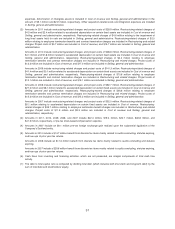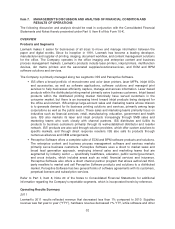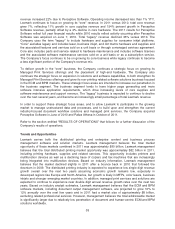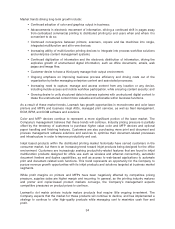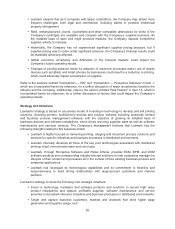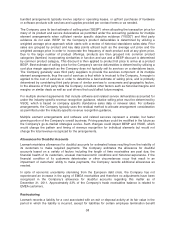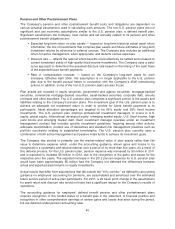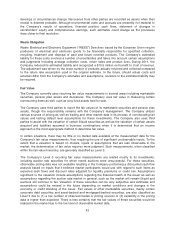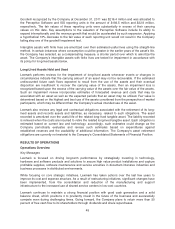Lexmark 2011 Annual Report Download - page 45
Download and view the complete annual report
Please find page 45 of the 2011 Lexmark annual report below. You can navigate through the pages in the report by either clicking on the pages listed below, or by using the keyword search tool below to find specific information within the annual report.Income Taxes
The Company estimates its tax liability based on current tax laws in the statutory jurisdictions in which
it operates. These estimates include judgments about deferred tax assets and liabilities resulting from
temporary differences between assets and liabilities recognized for financial reporting purposes and
such amounts recognized for tax purposes, as well as about the realization of deferred tax assets. If
the provisions for current or deferred taxes are not adequate, if the Company is unable to realize
certain deferred tax assets or if the tax laws change unfavorably, the Company could potentially
experience significant losses in excess of the reserves established. Likewise, if the provisions for
current and deferred taxes are in excess of those eventually needed, if the Company is able to realize
additional deferred tax assets or if tax laws change favorably, the Company could potentially
experience significant gains.
Under the accounting guidance regarding uncertainty in income taxes, a tax position must meet the
minimum recognition threshold of “more-likely-than-not” before being recognized in the financial
statements. The evaluation of a tax position in accordance with this guidance is a two-step process.
The first step is recognition: The enterprise determines whether it is more likely than not that a tax
position will be sustained upon examination, including resolution of any litigation. The second step is
measurement: A tax position that meets the more-likely-than-not recognition threshold is measured to
determine the amount of benefit to recognize in the financial statements. The tax position is measured
at the largest amount of benefit that is greater than 50 percent likely of being realized upon ultimate
resolution.
Litigation and Contingencies
In accordance with FASB guidance on accounting for contingencies,Lexmark records a provision for a
loss contingency when management has determined that it is both probable that a liability has been
incurred and the amount of loss can be reasonably estimated. Although the Company believes it has
adequate provisions for any such matters, litigation is inherently unpredictable. Should developments
occur that result in the need to recognize a material accrual, or should any of the Company’s legal
matters result in a substantial judgment against, or settlement by, the Company, the resulting liability
could have a material effect on the Company’s results of operations, financial condition and/or cash
flows.
Copyright Fees
Certain countries (primarily in Europe) and/or collecting societies representing copyright owners’
interests have taken action to impose fees on devices (such as scanners, printers and multifunction
devices) alleging the copyright owners are entitled to compensation because these devices enable
reproducing copyrighted content. Other countries are also considering imposing fees on certain
devices. The amount of fees would depend on the number of products sold and the amounts of the fee
on each product, which will vary by product and by country. The Company has accrued amounts that
represent its best estimate of the copyright fee issues currently pending. Such estimates could change
as the litigation and/or local legislative processes draw closer to final resolution.
Environmental Remediation Obligations
Lexmark accrues for losses associated with environmental remediation obligations when such losses
are probable and reasonably estimable. In the early stages of a remediation process, particular
components of the overall obligation may not be reasonably estimable. In this circumstance, the
Company recognizes a liability for the best estimate (or the minimum amount in a range if no best
estimate is available) of its allocable share of the cost of the remedial investigation-feasibility study,
consultant and external legal fees, corrective measures studies, monitoring, and any other component
remediation costs that can be reasonably estimated. Accruals are adjusted as further information
41


